Qingyu, Bai 3035693480
Jiarui, Zhu 3035638791
video: https://youtu.be/59Y15c8K1tc
alternative video: https://drive.google.com/file/d/1ncK0U1rYC7zts9HkevALsbKbqm4SyOEa/view?usp=sharing
Q: Hello everyone, today we are going to discuss the film “City of Glass”. It is a Hong Kong film released in 1998. The story follows the affair of Gangshen and Yunwen, alumni of the University of Hong Kong, and the love story of their children, David and Susie. The movie was nominated and awarded, at the Golden Horse Awards and the Hong Kong Film Awards. It is named after the “City of Glass”, which symbolizes the city’s fragile and shining aspects.
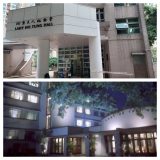
A: Before talking about the film itself, I wanna discuss the background first. Director Cheung Yuen-ting and screenwriter Lo Kai-yui are both alumni of the University of Hong Kong. During her university days, Cheung lived in Lady Ho Tung Hall. The demolition and rebuild of Lady Ho TungHall scheduled in January 1998 led Cheung to make this film, to commemorate the former Lady Ho Tung Hall and her university life there.
Q: The story begins with the fatal car accident of Gangshen and Yunwen in London. The director uses iconic buildings instead of subtitles to show the location.
A: Yes. At the beginning of the movie, we can see Big Ben, the Thames, and Westminster Palace appear in the frame as crowds of people celebrating the New Year run by. The film’s camera followed the car driven by Gangshen and Yunwen, used a series of rapidmontage shots to create tension and foreshadow the accident. Finally used upside-down architectures to show the consequence. The car crash is apivotal moment in the movie, marking the end of the two main characters’ love story and the start of their children’s journey.
Q: Besides the spatial background of the story, can you further discuss the narrative technique used in this film?
A: Sure. It uses a non-linear narrative structure, incorporating flashbacks and flash-forwards. It then switches to the two children handling the aftermath of the accident and reminiscing about their parents’ relationship. The movie interweaves their and their children’s love stories in a non-linear fashion, adding complexity and depth to the plot.
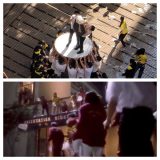
Q: The movie also portrays the hall culture at the University of Hong Kong. How does it do so?
A: The movie prominently features the hall cultureat HKU, including the Gong Fight between Lady Ho Tung Hall and Ricci Hall, ball practices for the inter-hall match, the hazing of new members, the High Table dinner, and the Hall Dance. These elements provide a glimpse into the traditions, hierarchy, and customs of the university culture in different eras.
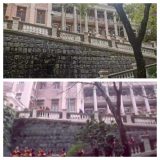
Q: Moreover, many interactions between Gangshen and Yunwen are based on the background of hall culture. In one scene, Gangshen gave flowers to Yunwen during the high table dinner, with the main building and the road in the background. Is it the road leading to Pokfulam Road?
A: Yes that’s right. Following the movement of Gangshen’s bike, our view gradually moves down from the main building on the hill, past the Pokfulam Road and then to the entrance of the Lady Ho Tung Hall. The acceleration suggests the excitement of the two people in love who are about to meet each other. In the night scene, the director adds layers of architecture by using large spotlights on the ground floor of the main building outward.
Q: At the same location, The dog that Gangshen and Yunwen used to keep was hit by a cyclist, then David and Susie took thedog to the hospital together. Can you discuss the significance of this plot?
A: The scene where little B is hit by a bicycle and taken to the vet serves as a metaphor for David and Susie, the two descendants. The director uses a voice-over to have the dog speak, suggesting that the dog, like the two young people, is an unwanted and neglected child. The hill where the accident took place showed up when Yunwen was punished to buy ice cream for her hall senior. This connection highlights the continuity of tradition and location over time.
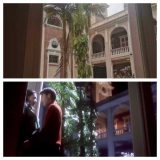
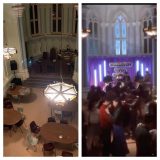
Q: The relationship between Gangshen and Yunwen was further enhanced during the prom co-hosted by the two halls. Do you want to discuss the prom and the scene after it?
A: This clip contains two main scenes, the dining hall in the University Hall and the courtyard of the main building. In the scene of Uhall, unlike the buildings commonly inhabited by the working class in Hong Kong in the 1970s, the dancing hall has a high floor height and large transparent windows, showing the relatively high social class of university students at that time. In the courtyard scene, the European-style architecture of the main building and the lights spilling from the corners create a relatively private atmosphere, paving the way for the intimate scenes later in this place.
Q: Gangshen and Yunwen’s college life experience ups and downs against the backdrop of the turbulent 1970s in Hong Kong. Yunwen accompanies Gangshen on a demonstration to defend Diaoyu Island, which results in Gangshen being jailed.
A: The plot here is actually based on a real historical event. In 1970, the United States handed over the Diaoyu Island to Japan without permission, which led to a wave of Chinese defending the islands in the 1970s. In the famous “July 7 demonstration to defend the Diaoyu Islands” in Victoria Park, Superintendent Willie of the Royal Hong Kong Police Force led more than 1,000 police officers to disperse the demonstrators by force in a nearly one-to-one ratio, and 21 people were arrested. This kicked off the student movement in Hong Kong in the 1970s.
Q: As a result of the demonstration fiasco, Gangshen was expelled from the University. Then, he had to work on his own to gather enough money to attend university in France, which eventually led to a change in his relationship with Yunwen.
A: During Gangshen’s detention, Yunwen prepared many gifts to visit. We can see the portraits of Queen Victoria and the Governor of Hong Kong on the wall of the prison, accounting for the background of Hong Kong still being a colony at that time.
Q: The film employs various techniques to depict the social and political changes in Hong Kong before and after the handover. Can you give us some examples?
A: Sure. One example is the scene where Gangshen and Yunwen, meet in a Mandarin class. This scene reflects the government’s effort to promote the use of Mandarin in Hong Kong as part of the preparation for the handover. Another example is during dinner, they talk about their acquaintances who have emigrated overseas, showing the wave of emigration that occurred before the handover. By highlighting the changes in language and culture, the film creates a sense of tension and uncertainty that pervades the city. It also explores the different ways in which individuals and families responded to these changes, whether by embracing them or resisting them.
A: At the end of the film, Susie and David board a traditional Chinese sailboat in Victoria Harbour to celebrate the handover of Hong Kong. We can still see this ship with big red sails in Victoria Harbor now. They set off fireworks in Victoria Harbour, and this firework brings the picture back to all the happy memory of Gangshen and Yunwen before they die in the car accident.
Q: How does the film balance its depiction of historical events with the characters’ personal stories? How successful do you think the film is, in portraying the historical and political background of Hong Kong before and after the handover?
A: The film uses the characters’ personal stories as a way to explore the large historical context. By showing how their lives are affected by the changes taking place, the film creates a nuanced and complex portrayal of the impact of the handover. The film also uses the characters’ relationships and experiences to humanize changes, making them more relatable to viewers. Overall, this film is very successful in its portrayal of the historical background of Hong Kong, and raises important questions about the meaning of identity, belonging, and community.
The podcast explains well how historical and political moments are reflected in the narrative of the film. There is some brief analysis of how camera angles and architectural elements portray the movie but it would be beneficial to include more analysis on the architecture or set of the movie and how it contributes to the narrative arc instead of focusing too much on the characters. What is the significance of the title City of Glass? What is the effect of this metaphor and how does that comment on modernity? The writing could also be more engaging and perhaps a comparison between Hong Kong then and now, a commentary on the changes between portrayal and reality would add more intrigue.